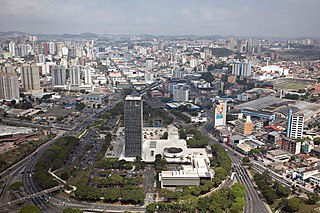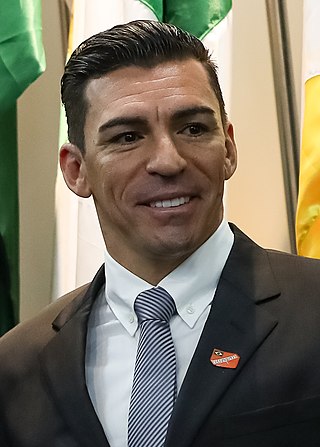Related Research Articles

Walkman, stylised as WALKMAN (ウォークマン), is a brand of portable audio players manufactured and marketed by Japanese company Sony since 1979. The original Walkman started out as a portable cassette player and the brand was later extended to serve most of Sony's portable audio devices; since 2011 it consists exclusively of digital flash memory players. The current flagship product as of 2022 is the WM1ZM2 player.

São Paulo is one of the 26 states of the Federative Republic of Brazil and is named after Saint Paul of Tarsus. It is located in the Southeast Region and is limited by the states of Minas Gerais to the north and northeast, Paraná to the south, Rio de Janeiro to the east and Mato Grosso do Sul to the west, in addition to the Atlantic Ocean to the southeast. It is divided into 645 municipalities and its total area is 248,219,481 square kilometres km², which is equivalent to 2.9% of Brazil's surface, being slightly larger than the United Kingdom. Its capital is the municipality of São Paulo.

The First Brazilian Republic, also referred to as the Old Republic, officially the Republic of the United States of Brazil, refers to the period of Brazilian history from 1889 to 1930. The Old Republic began with the deposition of Emperor Pedro II in 1889, and ended with the Brazilian Revolution of 1930 that installed Getúlio Vargas as a new president. During the First Brazilian Republic, Brazil was dominated by a form of machine politics known as coronelism, in which the political and economic spheres were dominated by large landholders. The most powerful of such landholders were the coffee industry of São Paulo and the dairy industry of Minas Gerais. Because of the power of these two industries, the Old Republic's political system has been described as "milk coffee politics."
Orlando (1914–2002) and his brothers Cláudio (1916–1998) and Leonardo Villas-Bôas (1918–1961) were Brazilian brothers who worked in indigenous activism. In 1961 they succeeded in getting the entire upper Xingu legally protected, making it the first massive indigenous area in all South America, and the prototype for dozens of similar reserves all over the continent.

The Stereobelt was a personal stereo player devised by Andreas Pavel, a former television executive and book editor. Pavel filed a patent of invention for his portable music player in Italy in 1977, and adopted the same protective steps in Germany, United Kingdom, United States, and Japan. He sought royalty fees and later commenced legal proceedings against Sony Corporation after the Walkman released commercially in 1979, believing the electronics manufacturer had infringed his intellectual property. Judges ruled against him, revoking the patent, stating his concept was "not significantly inventive".

José Serra Chirico is a Brazilian politician who has served as a Congressman, Senator, Minister of Planning, Minister of Health, Mayor of São Paulo, Governor of São Paulo state, and Minister of Foreign Affairs of Brazil.

São Bernardo do Campo is a Brazilian municipality in the state of São Paulo.

Vilém Flusser was a Brazilian Czech-born philosopher, writer and journalist. He lived for a long period in São Paulo and later in France, and his works are written in many different languages.

Lucimar Ferreira da Silva, commonly known as Lúcio, is a Brazilian former professional footballer who played as a centre-back. A tall and physically strong defender who excelled in the air, Lúcio was known for his long, surging, galloping runs on the ball, which earned him the nickname O Cavalo.

Father Roberto Landell de Moura, commonly known as Roberto Landell, was a Brazilian Roman Catholic priest and inventor. He is best known for his attempts in the 1880s to develop long-distance audio transmissions device that combined an improved megaphone device and a photophone .. Landell received patents in Brazil and the United States during the first decade of the 1900s in which he also included designs that he claimed could transmit voice using radio waves.
Brígida Baltar was a Brazilian visual artist. Her work spanned across a wide range of mediums, including video, performance, installation, drawing, and sculpture. She was interested in capturing the ephemeral in her artwork.

Anderson Hernanes de Carvalho Viana Lima, known as Hernanes, is a Brazilian former professional footballer who played as a central or attacking midfielder.
Livio Abramo was a Brazilian-born Paraguayan sketcher, engraver, and aquarellist.

Brazil had an official resident population of 203 million in 2022, according to IBGE. Brazil is the seventh most populous country in the world, and the second most populous in the Americas and Western Hemisphere.

Gretta Sarfaty, born Alegre Sarfaty, is also known as Gretta Grzywacz and Greta Sarfaty Marchant, also simply as Gretta. is a painter, photographer and multimedia artist who earned international acclaim in the 1970s, from her artistic works related to Body art and Feminism. Born in Greece, in 1947, she moved with her family to São Paulo in 1954, being naturalized as Brazilian.
Irish Brazilians are Brazilian citizens of Irish ancestry, or Irish-born people residing in Brazil, and vice-versa. Many Irish immigrants to Brazil changed their surnames to resemble Portuguese names more closely, often losing the common prefix 'O'.

The Pinacoteca do Estado de São Paulo is one of the most important art museums in Brazil. It is housed in a 1900 building in Jardim da Luz, Downtown São Paulo, designed by Ramos de Azevedo and Domiziano Rossi to be the headquarters of the Lyceum of Arts and Crafts. It is the oldest art museum in São Paulo, founded on December 24, 1905, and established as a public state museum since 1911.

Sergio Valle Duarte (born September 26, 1954) is a Brazilian multimedia artist and fine-art photographer.
Geraldo de Barros was a Brazilian painter and photographer who also worked in engraving, graphic arts, and industrial design. He was a leader of the concrete art movement in Brazil, co-founding Grupo Ruptura and was known for his trailblazing work in experimental abstract photography and modernism. According to The Guardian, De Barros was "one of the most influential Brazilian artists of the 20th century." De Barros is best known for his Fotoformas (1946-1952), a series of photographs that used multiple exposures, rotated images, and abstracted forms to capture a phenomenological experience of Brazil's exponential urbanization in the mid-twentieth century.
Mariannita Luzzati is a Brazilian visual artist from São Paulo, recognized for her extensive study of landscapes.
References
- ↑ Dumout, Estelle (June 4, 2004). "Sony pays millions to inventor in Walkman dispute". CNET News.
- ↑ Rohter, Larry (December 17, 2005). "Unlikely trendsetter made earphones a way of life". The New York Times.